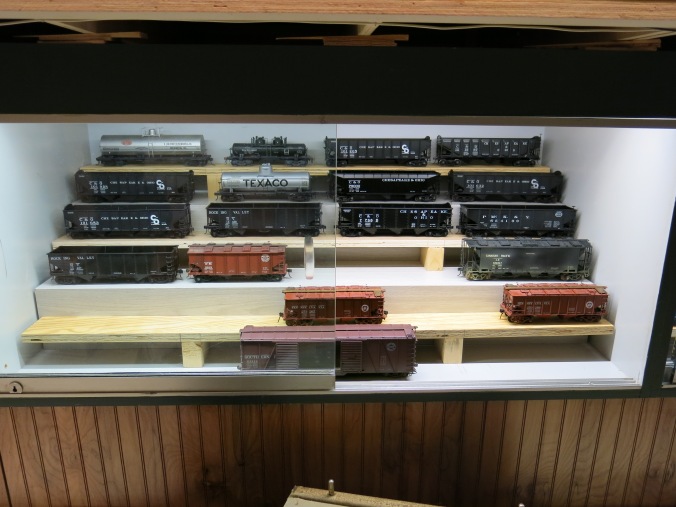In July, while I was in the U.S. to help with St. Louis RPM, I invited myself to Jeff Kuebler’s house in Columbia, Illinois for a layout tour. Jeff is one of the finest men you could ever meet, and is part of the St. Louis RPM crew, and he’s also an accomplished L&N modeler and historian. We had a couple of beers and a great visit.
Lately Jeff and I have been trading e-mails on tree-building and I thought this would be a good time to write something about his layout and show how he’s making unique trees for a signature scene on his layout.

Here are some words from Jeff about his layout. Jeff writes,
I model the Louisville and Nashville Railroad set in May of 1955 on both the Cincinnati-Corbin, KY (the “C-C” and Eastern Kentucky (“EK”) Divisions.
I have focused on modeling 50 miles of railroad between North Cabin and Ford, KY on the C-C and Patio and Ravenna on the EK. This area’s scenic highlights include the at-grade crossing with the C&O RR at Winchester, KY with it’s dual-sided passenger and freight stations, Patio tower and yard—where the divisions split—Winchester Hill, the double bridges and tunnels at Ford, the Red River Viaduct, L&N’s tallest bridge, and finally Ravenna yard. Hidden staging yards represent DeCoursey and Corbin on the C-C Division and Lexington and Hazard on the EK Division.
I model the early 1950s time period for the inclusion of first generation diesels as well as the “Big Emma”, L&N’s largest steam engines, and also to include the last gasp of L&N passenger operations. The “Big Emma” Berkshires were used as helpers on both divisions uphill towards Patio yard. Modeling the first week of May allows spring and summer vegetation as well as some extra traffic for Kentucky Derby Specials bound for Louisville.
I’ve been building equipment and structures for almost 30 years, but started getting serious on scenery building only in the last three years. My model of the famous Red River Viaduct is a scaled-down version that is modeled in just 7-1/2 feet. A foot-per-foot Red River Viaduct model would be almost 24 feet in length–that would eat up my whole basement. A faithful attempt was made to replicate the bridge and the place, which has led me to modeling Eastern Red Cedar trees. There are pockets of tens to hundreds of these trees along the hills and right of way on the EK Division of the L&N. Without a cost-effective retail-ready alternative, I came up with a solution to the problem that was relatively simple and easy and effective for the layout.
We’ll cover tree-building later, but for now, let’s take a walk around the railroad. Here, below, is the view as you walk in. Jeff has installed swing gates for both levels here. The room is about 25 x 25 and Jeff has jammed a whole lot of double-deck layout into the space.

Opposite the entrance, here’s a view of both decks, with Cumberland Yard on top and coal trains rolling on the bottom.

Here’s the big mine on the helix-end.

And here’s the mind on the other side.

Around the corner, at the center of the layout, is Jeff’s version of Patio Yard, an iconic location on The Old Reliable and a favorite of layout operators.

These two scenes below demonstrate Jeff’s transition-era setting.

Below, the famous Patio tower is easily recognizable. Love those green L&N tool houses!

Here’s Jeff, below, running a coal train into Patio. Jeff’s layout is DC—yep, you read that right—DC, with plug-in throttles. It runs great!

Opposite Patio Yard are two centrally-located staging yards, both of which are contained in a wide, three-turn helix. The coal mine in the background is an “empties-in, loads-out” operation and is another signature scene on the layout. The control panel routes power into and out of the helixes. That’s my beer on top…

Only about 25% of the layout has scenery. Here’s another view of the peninsulas in the back of the room. Space in the peninsulas is pretty tight which is why Jeff doesn’t open it up to many large groups or St. Louis RPM visitors.

Jeff is an accomplished modeler and he’s gone to great lengths to scratchbuild specific buildings for specific scenes. The tower below is a one-of-kind model of Baxter Tower made by Lake Junction Models that stood on the Cumberland Valley Division between Loyall and Harlan, Kentucky. The prototype tower was closed in the 1920s but Jeff modeled it as if it stayed open, and moved it to a proper location on the EK Division.

The L&N yard office below is a scratch built model from a Model Railroader article from the 70s. Jeff wrote, The prototype was actually in New Orleans, but I needed a real L&N office about that size for Patio Yard so I built this one. The tool sheds and motor car shed are laser kits from AMB which I helped the L&N HS supply prototype information and paint colors for production of the HO kits. I have scratch built two and still need about 14 more for the layout. Laser kits were the only way to go to get them done in a reasonable time frame. Thankfully AMB came through with some easy to build models!!

Here’s a terrific gas station scene, scratch built by Jeff.

And here’s the pride of the fleet, L&N 1964, one of 42 “Big Emmas”. This is a brass import with great sound added. DC sound–you don’t find too many models like this any more.

The Red River Viaduct Scene
The Red River Viaduct is on the EK Division, near Sloan, Kentucky, at milepost 219. Patio and Ravenna are separated by 26 rail miles on the EK and the Red River Viaduct falls roughly halfway between the two towns. In this modern-era view below, note how the Evergreens—Red Cedars—dominate this scene, even in winter.

When I visited, the scene on Jeff’s layout looked like this:

Since then Jeff’s been rockin’ and rollin’ and today the scene looks like this. He’s doing some fast work!

Jeff did a ton of work on the scene, starting with modeling the Red River and working his way up.
Jeff wrote, After years of searching for a good way to model Red Cedar trees made of natural materials, I gave up recently and tried with using sponges and dowels. I cut the sponges with scissors into rectangular blocks and then trimmed them to a point, and then slowly rounded them down the sides. I was careful to not make them look like Christmas trees by trimming the bottom back towards the trunk. I made a few larger ones first and then made smaller ones to go around them.
I painted the sponges with green spray paint and rolled them in dark green ground foam. Then I hit them with hair spray and roll on foam again.
I cut these 40 red Cedar Tree shapes of sponge blocks in about 70 minutes. Toothpicks snapped in half make easy trunks. I insert the pointy end into the trees.

It took about an hour to do the painting, rolling and sealing. The wood dowels are trimmed into pieces around 10 scale feet. My dowels are cotton-tipped swabs previously used for cleaning loco wheels. I have to leave just enough trunk showing so it can be planted and have about one foot viewable above the ground, Jeff said.
Here are about 40 of them ready for planting.

And here they are, below, installed by the bridge.

Jeff added a bunch of Sycamores too.

Now that you know the back-story, here’s that opening view again. What a great scene.

An Update: About ten seconds after I published this post, Lee Singletary from the L&N Historical Society e-mailed me this You Tube link, which features trains rolling on Jeff’s Red River Viaduct. You’ll enjoy it! Check it out at https://www.youtube.com/watch?v=Y-CpJd69fRM.
Thanks Jeff, for the tour and letting me tell the world about your layout! – John G





































